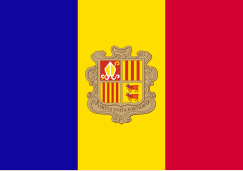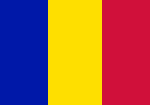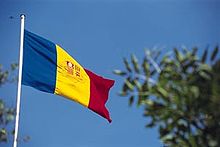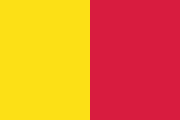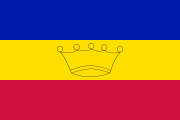
A national flag is a flag that represents and symbolizes a given nation. It is flown by the government of that nation, but can also be flown by its citizens. A national flag is typically designed with specific meanings for its colours and symbols, which may also be used separately from the flag as a symbol of the nation. The design of a national flag is sometimes altered after the occurrence of important historical events. The burning or destruction of a national flag is a greatly symbolic act.
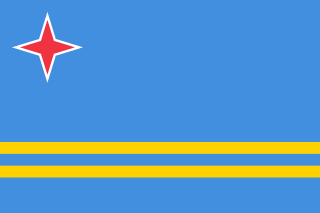
The national flag of Aruba was adopted on 18 March 1976, along with the official anthem "Aruba Dushi Tera". The flag was partially designed by vexillologist Whitney Smith. On 18 March Aruba celebrates National Anthem and Flag Day, marked by local events across the island. It is also a significant day as it represents the Kingdom of the Netherlands giving Aruba an autonomous status.

The national flag of Romania is a tricolour. The Constitution of Romania states that "The flag of Romania is tricolour; the colours are arranged vertically in the following order from the flagpole: blue, yellow, red". The flag has a width-length ratio of 2:3; the proportions, shades of colour as well as the flag protocol were established by law in 1994, and extended in 2001. Its similarity to the flag of Chad has caused international discussion.

The national flag of Poland consists of two horizontal stripes of equal width, the upper one white and the lower one red. The two colours are defined in the Polish constitution as the national colours. A variant of the flag with the national coat of arms in the middle of the white fess is legally reserved for official use abroad and at sea. A similar flag with the addition of a white eagle is used as the naval ensign of Poland.

The national flag of Guatemala, often referred to as "Pabellón Nacional" or "Azul y Blanco" features two colors: sky blue and white. The two sky blue stripes represent the fact that Guatemala is a land located between two oceans, the Pacific Ocean and the Atlantic Ocean ; and the sky over the country. The white signifies peace and purity. The blue and white colors, like those of several other countries in the region, are based on the flag of the former Federal Republic of Central America.

The flag of Bosnia and Herzegovina contains a medium blue field with a yellow right triangle separating said field, and there are seven full five-pointed white stars and two half stars top and bottom along the hypotenuse of the triangle.

The coat of arms of Andorra is the heraldic device consisting of a shield divided quarterly by the arms of the Bishop of Urgell and the Count of Foix – who have historically been the two co-princes of Andorra – in addition to the emblems of Catalonia and the Viscount of Béarn. Utilized unofficially since the Middle Ages, its status as the coat of arms of the Principality of Andorra was formalized in 1993 upon the implementation of their new constitution. The escutcheon is featured on the flag of Andorra.

The national flag of Colombia symbolizes that Colombia gained its independence from Spain on 20 July 1810. It is a horizontal tricolor of yellow, blue and red. The yellow stripe takes up a half of the flag and the blue and red take up a quarter of the space each.

The national flag of Ecuador, which consists of horizontal bands of yellow, blue and red, was first adopted by law in 1835 and later on 26 September 1860. The design of the current flag was finalized in 1900 with the addition of the coat of arms in the center of the flag. Before using the yellow, blue and red tricolor, Ecuador's former flag had three light blue stripes and two white stripes with three white stars for each province of the country.The design of the flag is very similar to those of Colombia and Venezuela, which are also former constituent territories of Gran Colombia. All three are based on a proposal by Venezuelan General Francisco de Miranda, which was adopted by Venezuela in 1811 and later Gran Colombia with some modifications. There is a variant of the flag that does not contain the coat of arms that is used by the merchant marine. This flag matches Colombia's in every aspect, but Colombia uses a different design when her merchant marine ships are at sail.

The flag of Peru was adopted by the government of Peru in 1825, and modified in 1950. According to the article 49 of the Constitution of Peru, it is a vertical triband with red outer bands and a single white middle band. Depending on its use, it may be defaced with different emblems, and has different names. Flag day in Peru is celebrated on 7 June, the anniversary of the Battle of Arica.

The flag of Uganda was adopted on 9 October 1962, the date that Uganda became independent from the British Empire. It consists of six equal horizontal bands of black (top), yellow, red, black, yellow, and red (bottom); a white disc is superimposed at the centre and depicts the national symbol, a grey crowned crane, facing the hoist's side.

The Senyera is a vexillological symbol based on the coat of arms of the Crown of Aragon, which consists of four red stripes on a yellow field. This coat of arms, often called bars of Aragon, or simply "the four bars", historically represented the King of the Crown of Aragon.

The following is a list of historical military colours, standards and guidons in different countries that do not exist today.

The flag of Crimea is the flag of the Autonomous Republic of Crimea in Ukraine and the Republic of Crimea controlled by Russia. The flag was officially adopted on 24 September 1992 as the flag of the Republic of Crimea, readopted on 21 April 1999, then readopted on 4 June 2014 as the flag of the Republic of Crimea, annexed by the Russian Federation.

The flag of Barcelona is the municipal flag of Barcelona, which combines the cross of Saint George, the patron saint of Catalonia, with the traditional red and yellow bars of the Senyera, the ancient symbol of the Crown of Aragon.

Futbol Club Andorra is a professional football club based in Andorra la Vella, Andorra, that currently competes in Segunda División, the second tier of the Spanish league system. The club was founded in 1942 and currently plays its home fixtures at Estadi Nacional. In spite of being based in the microstate of Andorra, the club, voluntarily affiliated to the Catalan Football Federation, has been allowed to compete in Spanish leagues since 1948.

The Jewish Autonomous Oblast is the only Autonomous Oblast in Russia. It is situated in the Far Eastern Federal District of Russia.

The colors of the national flag of Romania has a long history, though the association of the three colors only dates to the 18th century. Red, yellow and blue were found on late 16th-century royal grants of Michael the Brave, as well as shields and banners. Thus, the late 13th century Wijnbergen armorial shows the coat of arms of the Wallachian ruler Litovoi as consisting of a shield of ten vertically alternating gold-and-red bands,. The same two colors, gules and or, also appeared on the late 15th century flag and coat of arms of Moldavia, during the reign of Stephen the Great. Then, from the late 16th century until the mid-17th century, the historical coat of arms of Transylvania gradually developed as a shield party per fess, consisting of a black eagle on blue background in the upper field, a dividing red band in the middle, and seven red towers on golden background in the lower field. Finally, in the last quarter of the 18th century, Bukovina gets its own coat of arms from the Habsburg Empire, a blue-and-red shield party per pale with a black aurochs' head in the middle, and three golden six-pointed stars surrounding it. During the Wallachian uprising of 1821, these three colors were present, along others, on the canvas of the revolutionaries' flag and its fringes; for the first time a meaning was attributed to them: "Liberty (blue-sky), Justice, Fraternity ( blood)".

The flag of Yugoslavia was the official flag of the Yugoslav state from 1918 to 1992. The flag's design and symbolism are derived from the Pan-Slavic movement, which ultimately led to the unification of the South Slavs and the creation of a united south-Slavic state in 1918.

The flag that serves as the symbol of the historical and geographical region of the Western Pomerania is divided horizontally into two stripes: light blue on the top and white on the bottom. It originated as the flag of the Province of Pomerania, Prussia, used from 1882 to 1935. Since 1996, it is officially recognized as the symbol of the historical region of Western Pomerania within Mecklenburg–Western Pomerania, Germany.
